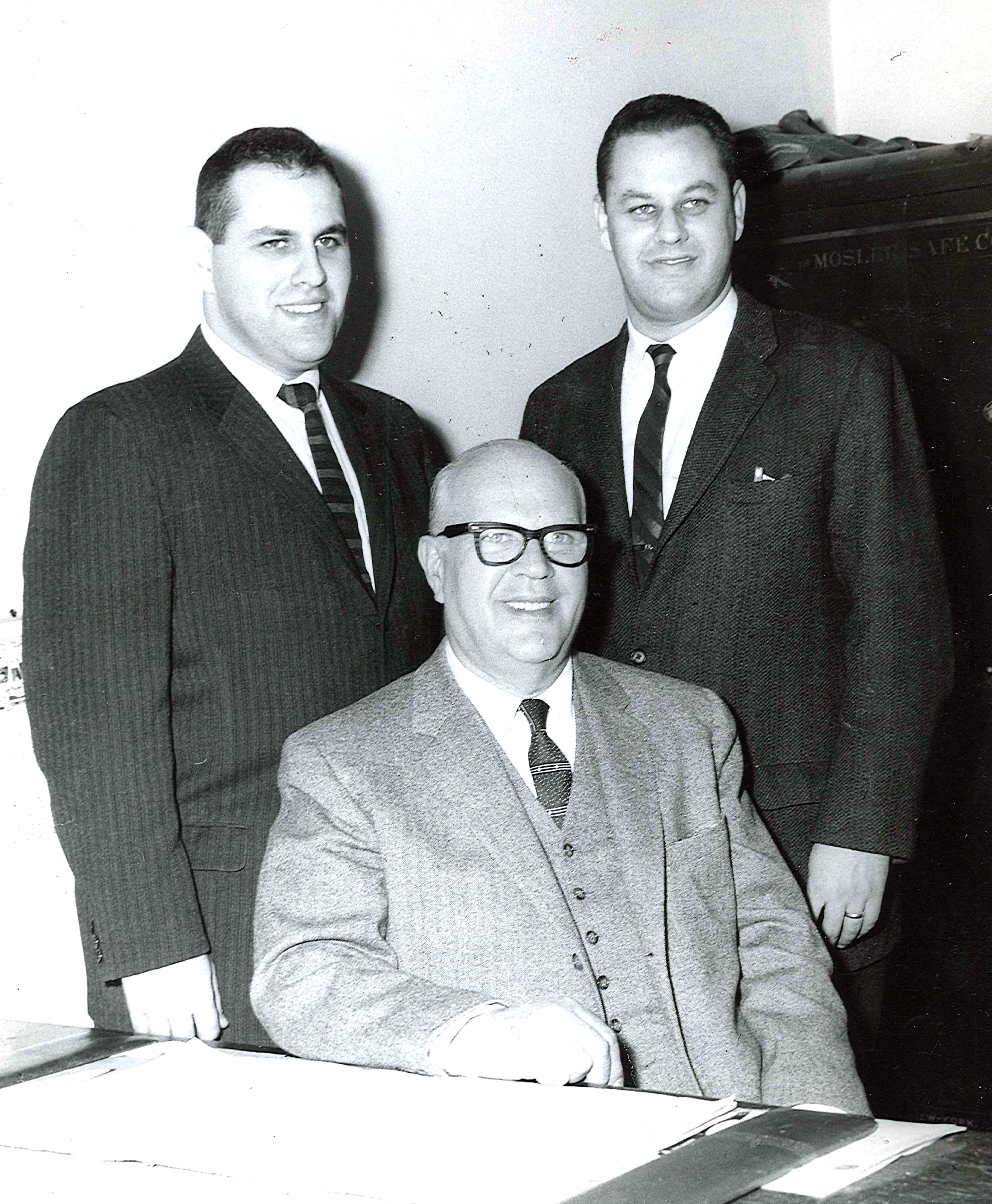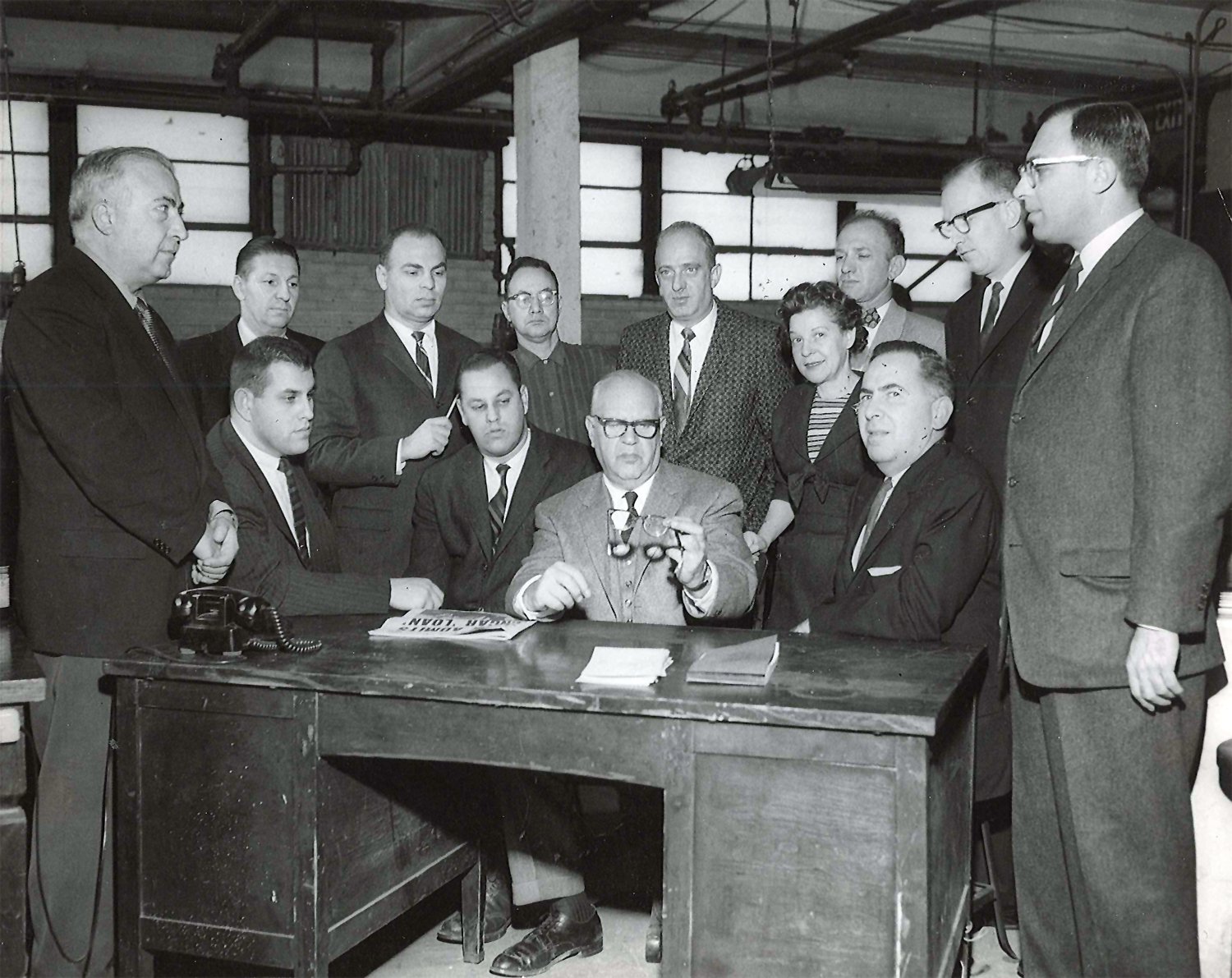Standing On the Shoulders of Giants
From left to right: Henry Shyer, Joseph Shyer, Robert Shyer
Joseph Shyer, Founder
The legacy began in 1923 with Joseph Shyer, an inventor, innovator, and pioneer rolled into one. Like the Wright Brothers 20 years earlier who altered the course of aviation, Joseph paved the way for the eyewear industry we know today. His is a true rags-to-riches story that captures the essence, and heart, of the American spirit.
Born in 1896 Joseph started selling pencils on NYC street corners at 13 to help support his family. After discovering he had a knack as a salesman, he got a better job selling plastic eyeglasses for a startup company, but then quickly realized he could do the same thing — and be his own boss. He founded Zyloware at age 26.
“Our grandfather was one of the first to take advantage of the new plastic material, whose trade name is Zyl, to make really beautiful frames,” said Chris. Invented by Dupont in 1916, the plastic offered not just a more comfortable fit, but adjustability and rich colorations, which up until then were nonexistent.
“Previously glasses had wire frames or were made out of tortoise shell—you literally had to kill a tortoise, no kidding!” Chris said. “And they were hard to come by.”
Over the next decade, even as Zyloware grew more successful, Joseph never lost his vision for building a company where employees would be treated well, fostering a family dynamic at a time when most CEOs led with an ‘‘I’m the boss and you’ll do exactly what I tell you” attitude.
“My grandfather wasn’t like that,” said Jamie. “He was treated poorly at a previous job and wanted to build a company where respect was baked into our core DNA, as it has been since 1923.”
During the Great Depression, Joseph filled an unused capacity in the factory making handbags, keeping everyone employed.
During World War II, Zyloware supported the war effort by making frames for the armed forces. In 1945, the Optical Manufacturers Association, a consortium of eyeglass manufacturers around the U.S. coming out of the war, was created to drive and grow consumer vision correction. Joseph was the founding president of the OMA, which later evolved into The Vision Council of today.
“He saw at that time that there was a need to grow the industry together – you could work with your competitors to build something that benefits all of us,” Jamie said.
“And,” added Chris, “he was personally driven to carry on the company with his sons. That’s his special legacy.”
Bob and Henry Shyer 2nd Generation
Robert (Bob) and Henry Shyer, brothers born two years apart, were the next generation of visionaries and innovators. True entrepreneurs, they identified needs in a marketplace and acted on them, managing the business and assuming the risk for its failure — or in their case, success.
Bob and Henry joined their father at Zyloware in the ‘50s, taking on roles that matched their personalities and skill sets to a T. Bob trained to run the factory, at that time in Long Island City, and like a sponge, soaked up everything he could from factory employees, especially about how frames fit — knowledge he ultimately passed down to his son Chris.
Henry, Jamie’s dad, was a gregarious, charming, witty, very lovable character who made friends of customers all over the world. “To know Henry was to love him,” Jamie says. At the same time he was a natural salesman, the likes of which the industry had never seen before! As they say, he could sell anything to anyone! He became the outward face of Zyloware.
The brothers became legends in the industry, not just for licensing the first American designer eyewear brand—which they did with Gloria Vanderbilt in 1976. Or for introducing the first celebrity brand license with the incomparably gorgeous Sophia Loren in the ‘80s. “More important, and much bigger,” said Chris, “is that they brought the authenticity of this fashion and beauty icon telling American women that it’s OK to wear glasses, that you could be beautiful wearing glasses.”
Here’s how the partnership with Sophia Loren happened (which captures the Shyer brothers in a nutshell).
After the successful launch of the Gloria Vanderbilt line — six months before her jeans hit the market! — Bob was watching “The Dick Cavett Show” (a predecessor of Johnny Carson for those too young to remember), and Sophia Loren was being interviewed and she was wearing eyeglasses.
Cavett said to her, “You are specifically known for your eyes. Why are you hiding behind those glasses?!” And she said something to the tune of, “Well, I think of them as a fashion accessory.” Bob Shyer thought to himself, who’s going to be a better spokesperson for the product? We’ve gotta talk to her!
So Bob went into work and said to Henry, “we need to get in touch with Sophia Loren!” And they had her on the phone that very afternoon!
Stetson Eyewear, which was introduced in 1982, conveyed the same message to American men: You could be rugged, masculine, authentic —not nerdy — and wear glasses. For both men and women, the novelty was that you’re not wearing a disabled-vision device, you’re wearing a fashionable accessory.
“That’s their main legacy,“ Chris said.
Chris and Jamie Shyer 3rd Generation
When Chris and Jamie took the helm and started running the business, they had big shoes to fill. And while both revered their fathers for their ingenuity, guts, and vision, there were definitely some father-son intergenerational arguments about where things were headed and how Zyloware needed to adapt.
According to Chris, in the 1980’s there was a seismic shift in how eyeglasses were distributed to doctors and consumers. European eyewear companies that had previously been making frames for distributors had figured out that they should set up their own distribution arm in the U.S. and sell directly to retailers. “From 1980 -1995, it went from 100% of frames being sold by laboratories to ECPs, down to 15%,” Chris said.
During the same time, optical chains started to appear on the scene, most notably Dr. Pearle of Pearle Vision, whose original nine stores became 1,200 locations. Chris and Jamie realized that the company needed to change along with the times.
Following a complicated period of hybrid distribution, the sons pivoted the company to selling directly to chains and doctors. As had been the case with Bob and Henry and their father Joseph, the Shyers’ willingness to change course was the reason Zyloware has continued so successfully to this day.
As co-CEOs, Chris and Jamie tend to collaborate on most things, their end goal is to be partners supporting the business needs of optical retailers, large and small.
“It goes without saying, first they need beautiful frames consumers want to wear that fit!” Chris said. Also now, those needs include high sell-through rates, keeping goods in stock, and having products that are high quality yet affordable. “Also offering market-friendly terms, having a full-service warehouse and supply chain, as well as the lowest backorder rates in the industry, and building products that can make our retail partners money in a difficult insurance market. A lot of our newer brands are really designed to do that,” Chris said.
One of their biggest accomplishments has been the creation of a company of experts —”first in marketing, but then with sales support, supply chain, quality control, warehousing, all the other services that other eyewear companies didn’t initially have,” said Chris. So they weren’t just the company that had the brands retailers wanted and consumers were now familiar with; they could also service multi-hundred-door optical retailers in a way in which others could not.
“We are a company of experts, honed to both optical and retail,” Chris said. “We built all these services so our retailers can be successful in a landscape that is quite competitive, both brick & mortar and online retailers. That’s part of our legacy.”
In the 2000’s Chris and Jamie presided over the enormous expansion of Zyloware’s fashion brands. Rather than just figuring out which were the coolest brands to partner with, they identified fashion trends and niches in the market—an aesthetic—that people were looking to wear and retailers needed. Sometimes they’d work directly with the retailers, both big and small, to identify those needs and custom-make collections for them.
During those years they also oversaw the launch of Zyloware’s B2B online presence with Zyloware.com and their social media platforms. In 2010, busting at the seams, the company moved its operations after 87 years in the Long Island City, NY location to their new state-of-the-art and environmentally friendly headquarters in Port Chester, N.Y.
Although both Shyers have successfully shepherded their company into the 21st century, there are tenets from their fathers that they still hold dear. One of which is learning to separate business from family.
“My dad said, ‘You can argue or disagree during business hours, but at the end of the day sit down and have dinner together’,” Jamie said. “Many family businesses fail because they don’t know how to do that.”
As they move toward the future — the next 100 years —”We are still going to be who we are,” Jamie said. “We will have the same core values, the same respect for our coworkers, diversity, open-mindedness and inclusion that is our DNA.“
“And,” Chris adds, “always listening and prepared to innovate and change.”
“That’s what makes us special, and successful, for ourselves and for our partners,” they believe. “We’re always going to stand out as a special kind of business.”
From left to right: Henry Shyer, Jamie Shyer, Robert Shyer, Christopher Shyer



